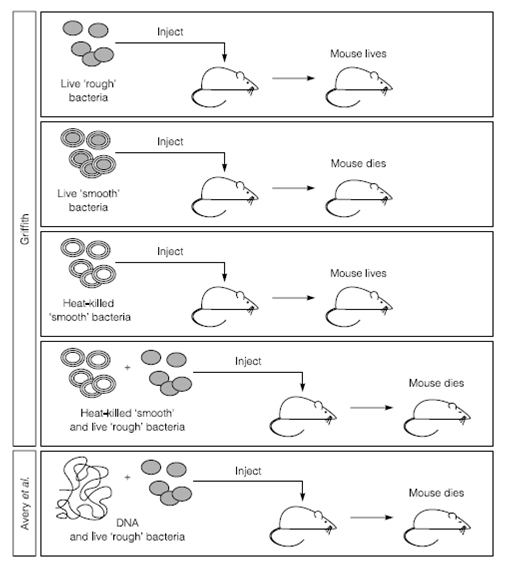DNA transforms bacteria
Although biochemistry was well advanced by 1930 the identity of the molecule responsible for the transfer of genetic information among mother and daughter cell was not agreed upon. Protein was held to be the most likely candidate as it held sufficient diversity in sequence to code for the many cellular variations. DNA had been purified as early as 1868 through Friedrich Miescher, from pus in surgical bandages and several of its characteristics determined but had not been explicitly linked to information flow. A breakthrough came in 1944 when Avery, MacLeod, and McCarty showed that DNA could confer virulence on nonpathogenic Streptococcus pneumoniae. This finding was built on earlier work by Griffith, who had shown that the same effect could be achieved with heat-killed bacteria in Figure .

Figure 1. DNA is the ‘transforming principle.’
Griffith defines virulent S. pneumoniae as smooth due to the appearance of the colonies on agar plates. The virulence factor is a capsule which causes the smooth colonies and allows the Bacterium to cause pneumonia in mice. The finding that live noncapsulate Bacteria could cause the death of mice when mixed and incubated with heat-killed capsulate bacteria was not fully explained at the time. Griffith did not fractionate S. pneumoniae but did suggest that a subcomponent of the capsulate Bacteria was responsible a component he called the transforming principle. The fractionation was performed through Avery, MacLeod and McCarty who went on to not only find that the principle was DNA but also propose that DNA was a carrier of genetic information. In many ways these experiments were a series of fortunate events, in that Griffith could have chosen many other Bacteria to study, but chose one that was naturally competent under the conditions he used. Furthermore, S. pneumoniae can be transformed by linear fragments of double-stranded DNA, and had Avery, MacLeod and McCarty carried out their experiments with E. coli, they would not have obtained like easily explained results. Meanwhile the debate over whether DNA was the only repository for genetic information continued.